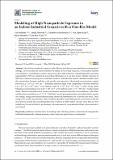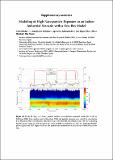Por favor, use este identificador para citar o enlazar a este item:
http://hdl.handle.net/10261/181856COMPARTIR / EXPORTAR:
 SHARE SHARE
 CORE
BASE CORE
BASE
|
|
| Visualizar otros formatos: MARC | Dublin Core | RDF | ORE | MODS | METS | DIDL | DATACITE | |

| Título: | Modeling of High Nanoparticle Exposure in an Indoor Industrial Scenario with a One-Box Model |
Autor: | Ribalta, Carla CSIC ORCID; Koivisto, Antti J.; Salmatonidis, Apostolos CSIC ORCID; López-Lilao, Ana; Monfort, Eliseo; Viana, Mar CSIC ORCID | Palabras clave: | Prediction Emission rates Air exchange rate Ultrafine particles Unintentional nanoparticles Worker exposure Incidental nanoparticles Particle mass concentration |
Fecha de publicación: | 14-may-2019 | Editor: | Multidisciplinary Digital Publishing Institute | Citación: | International Journal of Environmental Research and Public Health | Resumen: | Mass balance models have proved to be effective tools for exposure prediction in occupational settings. However, they are still not extensively tested in real-world scenarios, or for particle number concentrations. An industrial scenario characterized by high emissions of unintentionally-generated nanoparticles (NP) was selected to assess the performance of a one-box model. Worker exposure to NPs due to thermal spraying was monitored, and two methods were used to calculate emission rates: the convolution theorem, and the cyclic steady state equation. Monitored concentrations ranged between 4.2 × 104–2.5 × 105 cm−3. Estimated emission rates were comparable with both methods: 1.4 × 1011–1.2 × 1013 min−1 (convolution) and 1.3 × 1012–1.4 × 1013 min−1 (cyclic steady state). Modeled concentrations were 1.4-6 × 104 cm−3 (convolution) and 1.7–7.1 × 104 cm−3 (cyclic steady state). Results indicated a clear underestimation of measured particle concentrations, with ratios modeled/measured between 0.2–0.7. While both model parametrizations provided similar results on average, using convolution emission rates improved performance on a case-by-case basis. Thus, using cyclic steady state emission rates would be advisable for preliminary risk assessment, while for more precise results, the convolution theorem would be a better option. Results show that one-box models may be useful tools for preliminary risk assessment in occupational settings when room air is well mixed. | Versión del editor: | https://doi.org/10.3390/ijerph16101695 | URI: | http://hdl.handle.net/10261/181856 | DOI: | 10.3390/ijerph16101695 |
| Aparece en las colecciones: | (IDAEA) Artículos |
Ficheros en este ítem:
| Fichero | Descripción | Tamaño | Formato | |
|---|---|---|---|---|
| Modeling of High Nanoparticle Exposure in an Indoor Industrial Scenario with a One-Box Model.pdf | Artículo principal | 1,75 MB | Adobe PDF |  Visualizar/Abrir |
| Supplementary materials.ijerph-16-01695-s001.pdf | Material suplementario | 529,72 kB | Adobe PDF |  Visualizar/Abrir |
CORE Recommender
PubMed Central
Citations
6
checked on 23-mar-2024
SCOPUSTM
Citations
13
checked on 11-abr-2024
WEB OF SCIENCETM
Citations
10
checked on 28-feb-2024
Page view(s)
193
checked on 18-abr-2024
Download(s)
147
checked on 18-abr-2024
Google ScholarTM
Check
Altmetric
Altmetric
Artículos relacionados:
NOTA: Los ítems de Digital.CSIC están protegidos por copyright, con todos los derechos reservados, a menos que se indique lo contrario.
